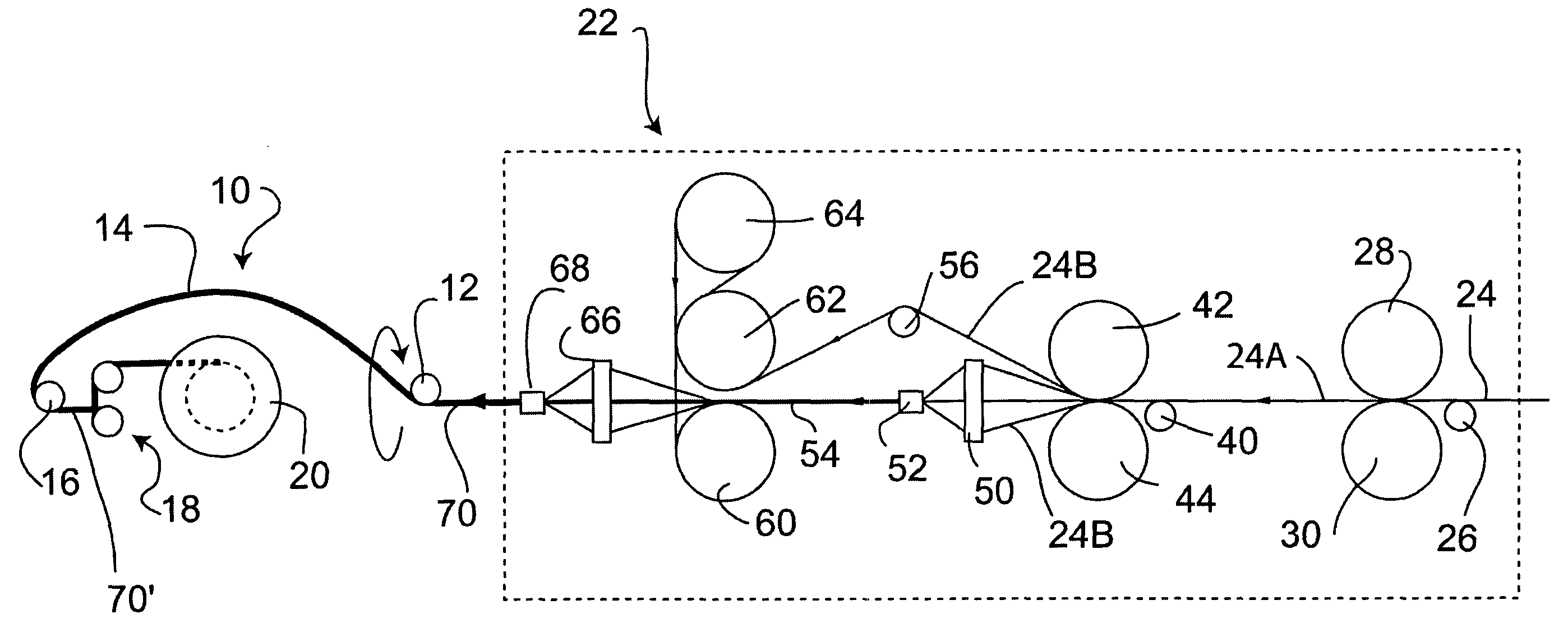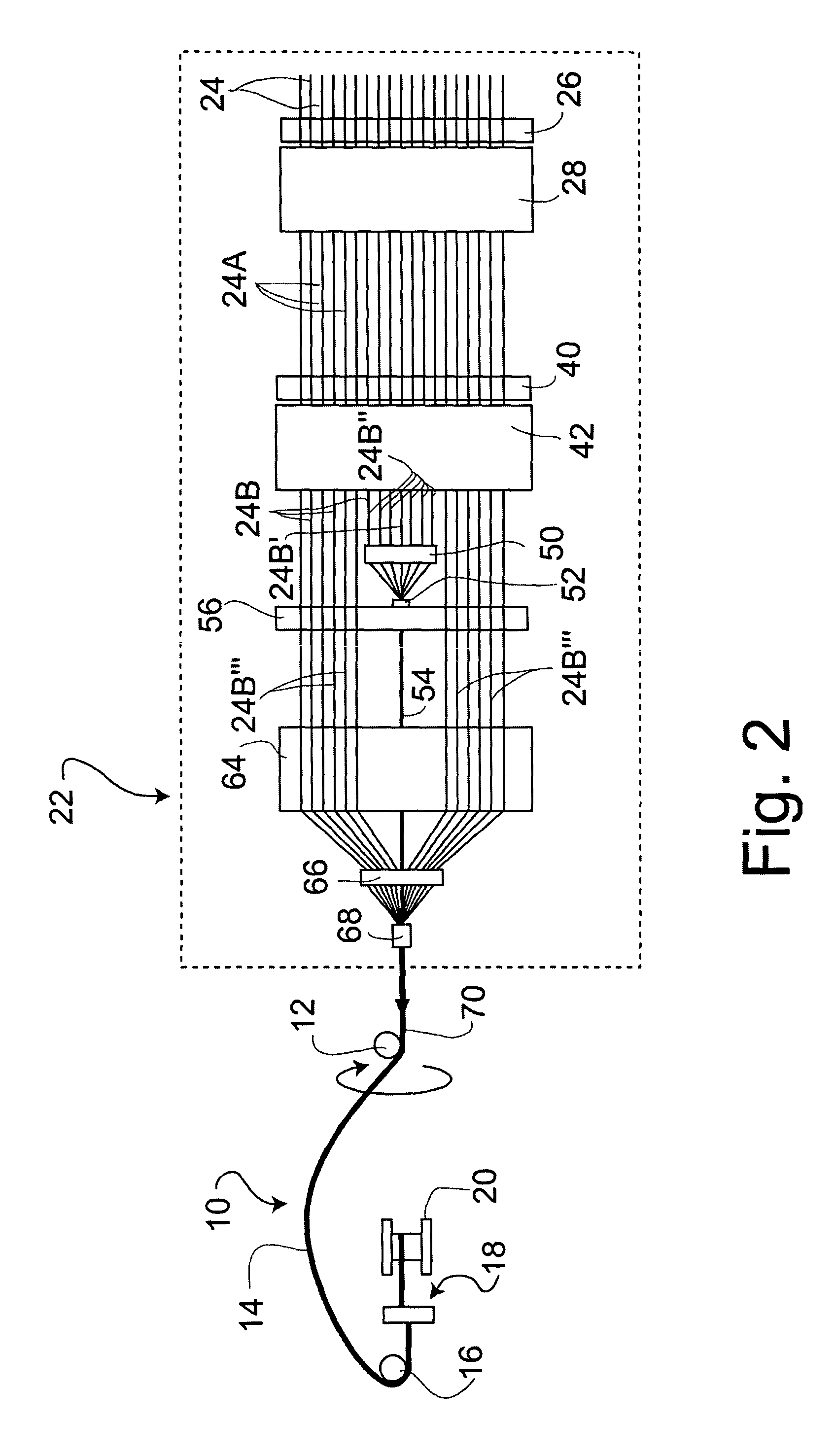[0014] An
advantage of the present invention, at least in its preferred forms, is that it can employ wires all of a single input size and shape, or just a small number of inpute wires of different size and possibly shape, to produce a large variety of standard cables of different gauge merely by changing the degree of working of the wires prior to twisting of the wires into standard cable formats.
[0015] When working with wires made of
aluminium or
aluminium alloy, there is a practical limit to the reduction of cross-sectional area that can be achieved in a
single step without causing unacceptable reductions of the
metal quality, e.g. potential for
cracking, fracturing or loss of elongation (generally referred to as “
brittleness”). This limit depends on the particular
alloy involved, but problems are normally encountered with area reductions of more than 40%, so care must be taken
not to exceed this limit (and, for safety, it is preferred
not to exceed 30%
area reduction). Area reductions of 25% or less are normally acceptable for aluminum alloys of all kinds used for electrical conductors. However, if wires of a single input size (outer
diameter or cross-sectional area) are to be used for the formation of cables of a variety of final standard gauges and wire formats, generally more than 30% reduction, and even as much as or more than 50% reduction, in cross-sectional area is likely to be required for the production of cables of some of the desirable gauges.
[0016] It has been found that, if the required total reduction of cross-sectional area is achieved using two or more rolling steps rather than just one, with each rolling step accomplishing less than a critical amount of
area reduction (i.e. certainly less than 40%, more preferably less than 30%, and ideally less than 25%), then a wire that is of acceptable quality can be produced in sizes suitable for the formation of a variety cables of differing standard gauges. In this way, wires of a single input size, or just a very few input sizes (preferably no more than two), can be used to form cables of a variety of final gauges without having to change the layering pattern of the cable, i.e. the number of wires per layer or the spacing of the wires within the cable, etc. An entirely conventional set of cables of varying gauges can thereby be produced from one or a few kinds of wire, thus reducing cost and complexity. A total reduction of cross-sectional area of up to 75% can be achieved using up to four rolling passes, e.g. by providing three rolling passes each imparting an
area reduction of 25%. However, it is normally the case that a broad range of cable sizes can be produced with a total area reduction of no more than about 50%, thus making it possible to provide just two rolling passes each of up to 25% area reduction.
[0017] The input wires are normally drawn from
metal rod by conventional techniques and are usually of round cross-section. Typically, the rod is of 9.5 mm AA1350, AA6201 or AA8000 series alloy and is drawn to standard sizes (e.g. 0.0982 inch or 0.1240 inch, or metric equivalents) using
diamond or
tungsten carbide dies. The drawn wire is then normally coiled on bobbins or spools, and then the coils, bobbins or spools are used for supplying a set of input wires to the method and apparatus of the present invention.
[0018] When using input wire of this kind, it will normally be possible to form at least one conventional cable of a particular gauge without reducing the cross-sectional area of the wire at all. It may also be possible to produce cables of one or more particular gauges with a
size reduction that can be achieved in a single rolling pass. However, the present invention makes it possible to produce cables having a larger number of different gauges, i.e. those gauges which require a reduction of the cross-sectional area of the wire to an extent that cannot safely be achieved in a single rolling step (e.g. 40% or more) without introducing unacceptable metal faults. The method and apparatus of the invention thus provides or enables multiple rolling steps so that such cables can be produced from wire of a single starting size orjust a few starting sizes.
[0019] It has furthermore been found advantageous, when using two rolling steps to produce the required final reduction of cross-sectional area and when starting with wire of circular cross-section, to roll the wire to a non-circular cross-section in a first rolling step (while also reducing the area within an acceptable range), e.g. an oval or
diamond-shape, and then to roll the wire to a circular cross-section (while also reducing the cross-sectional area to an acceptable extent) in the second rolling step. This helps to reduce “finning”, especially when the wire of non-circular cross-section is rotated through an angle in the range of 45-135°, preferably 85-95°, and ideally 90°, between rolling steps. Alternatively, adjacent roll stands may be mounted at a mutual angle in the stated ranges relative to each other, preferably at 90°, so that twisting of the wire can be avoided.
 Login to View More
Login to View More 


